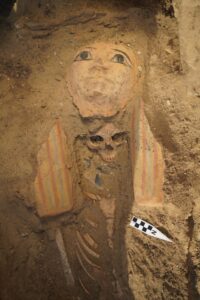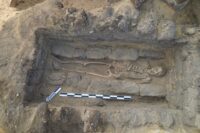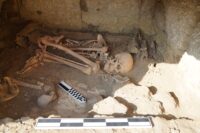 A joint Egyptian-Japanese archaeological mission excavating the Saqqara necropolis has discovered an intact rock-cut tomb dating to the Second Dynasty (ca. 2890 – ca. 2686 B.C.) of the Old Kingdom. The tomb contains the remains of an adult and a small child.
A joint Egyptian-Japanese archaeological mission excavating the Saqqara necropolis has discovered an intact rock-cut tomb dating to the Second Dynasty (ca. 2890 – ca. 2686 B.C.) of the Old Kingdom. The tomb contains the remains of an adult and a small child.
The architectural marvel, believed to date back to the Second Dynasty, boasts intricate designs and offers a glimpse into the craftsmanship of ancient Egyptian builders. The tomb’s design and the pottery discovered within it serve as significant markers for understanding the historical context of its creation.
Mustafa Waziri, the [Supreme Council of Antiquity’s] secretary-general, said that collaboration with Waseda University has proven to be fruitful, revealing a tomb that adds a new chapter to the rich history of Saqqara.
“The artefacts and burials uncovered provide a window into the lives of those who lived in this ancient civilization,” he pointed out.
 Archaeological remains from the Second Dynasty are much more rare than those from the First and Third. Even the names and regnal order of the pharaohs is unclear as the surviving king lists are lacunose and contradictory, with only the first three and the last one confirmed. The scarcity of Second Dynasty remains makes the newly-discovered tomb particularly significant.
Archaeological remains from the Second Dynasty are much more rare than those from the First and Third. Even the names and regnal order of the pharaohs is unclear as the surviving king lists are lacunose and contradictory, with only the first three and the last one confirmed. The scarcity of Second Dynasty remains makes the newly-discovered tomb particularly significant.
 The Second Dynasty tomb is by far the oldest, but the mission also discovered numerous other rock-cut tombs from the Late Period (712–332 B.C.) and Ptolemaic era (304–30 B.C.), containing numerous artifacts including pottery, painted face masks, statuettes and amulets of deities like Isis, Harpocrates and Bes.
The Second Dynasty tomb is by far the oldest, but the mission also discovered numerous other rock-cut tombs from the Late Period (712–332 B.C.) and Ptolemaic era (304–30 B.C.), containing numerous artifacts including pottery, painted face masks, statuettes and amulets of deities like Isis, Harpocrates and Bes.